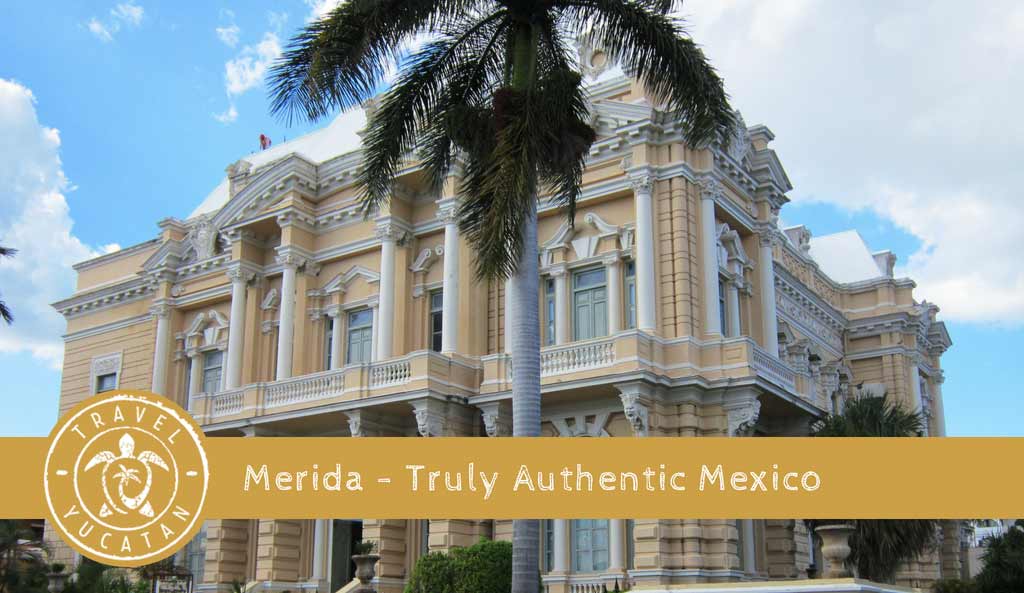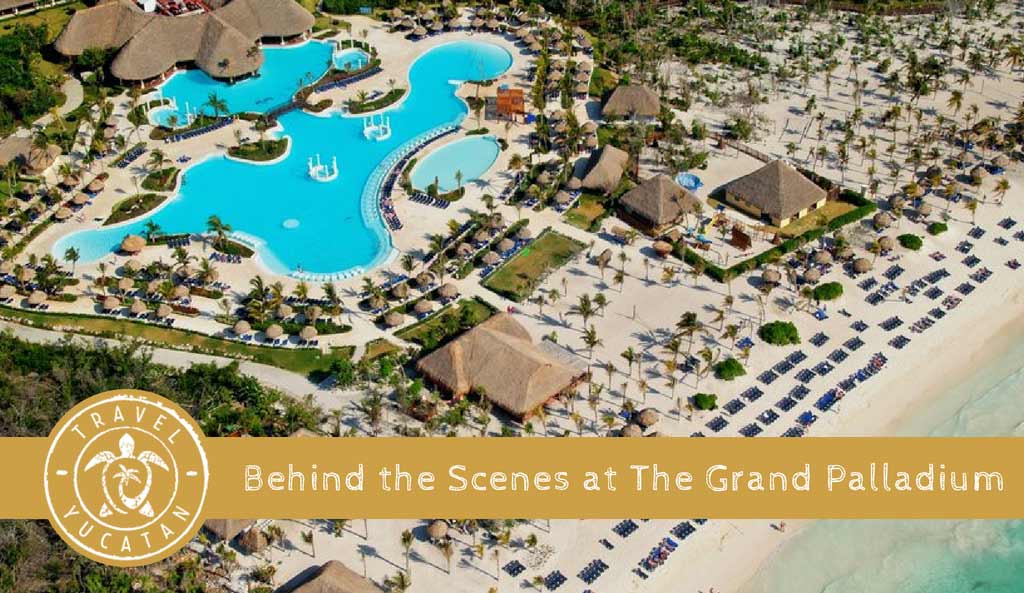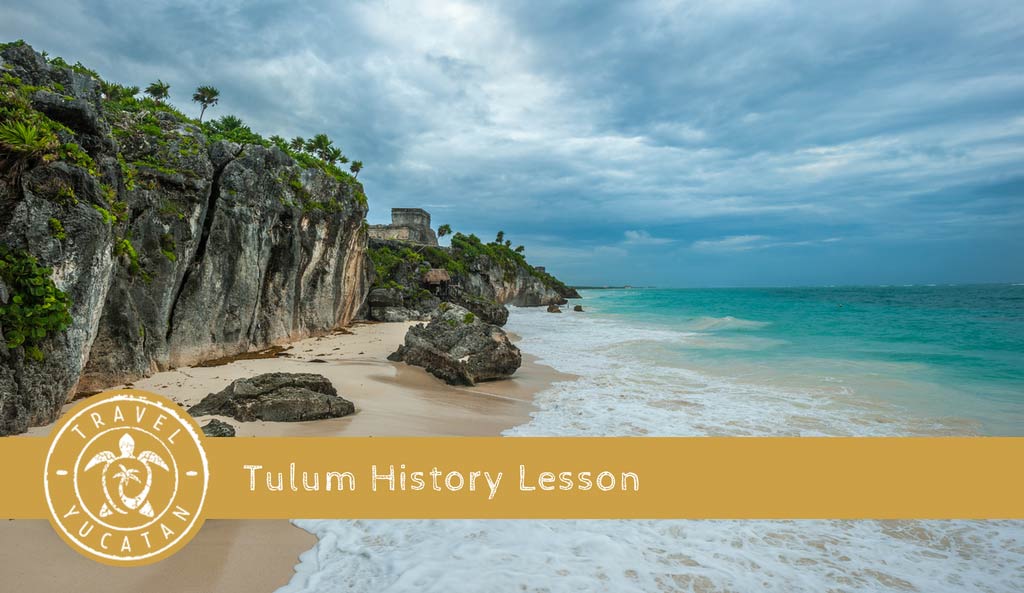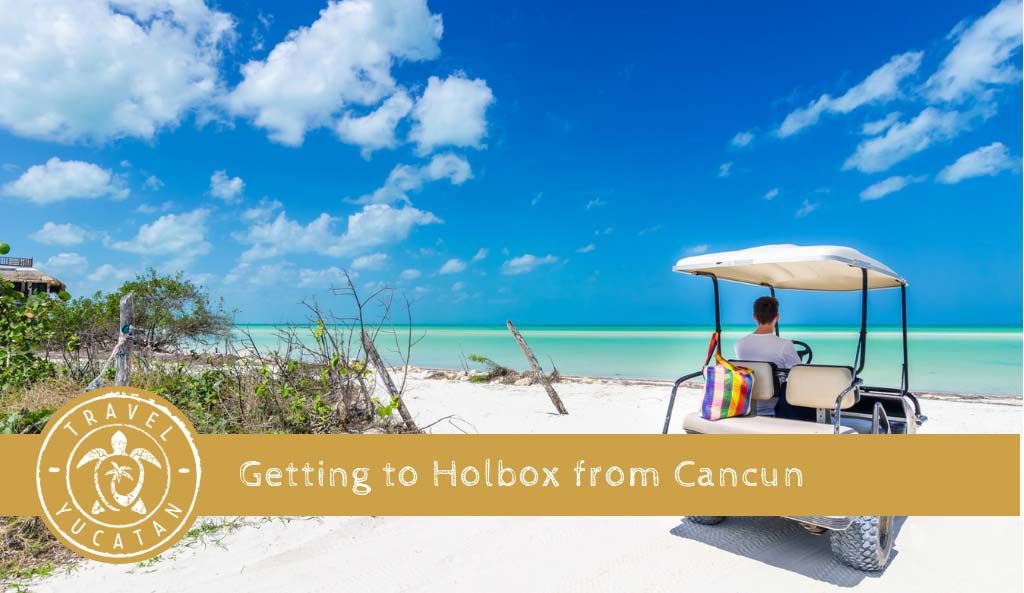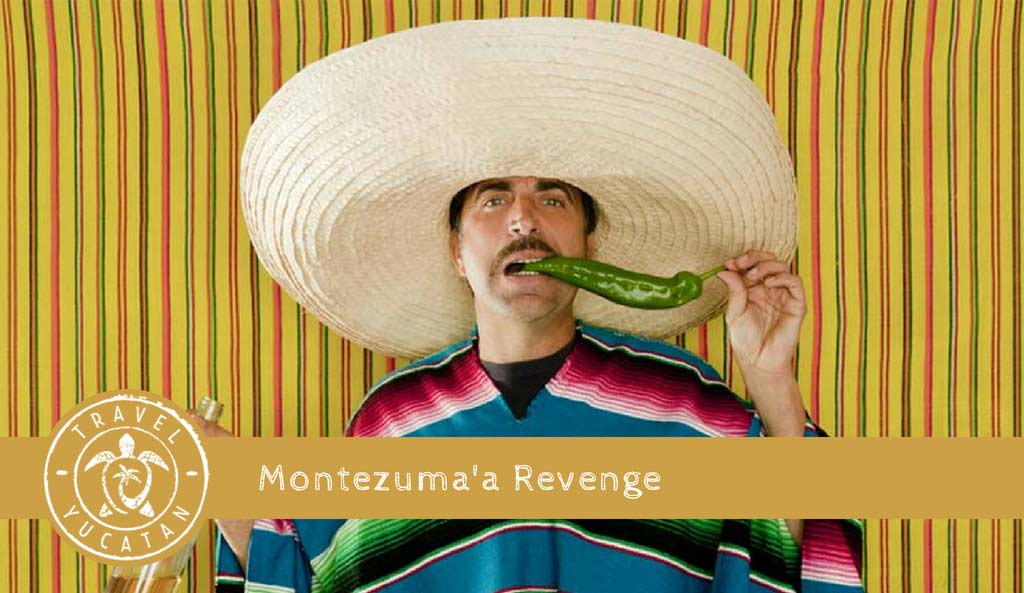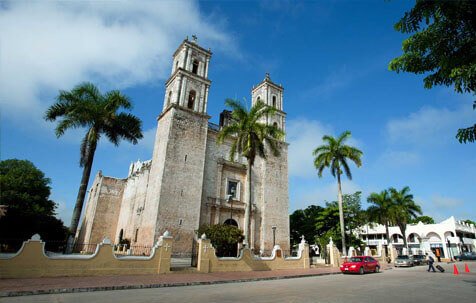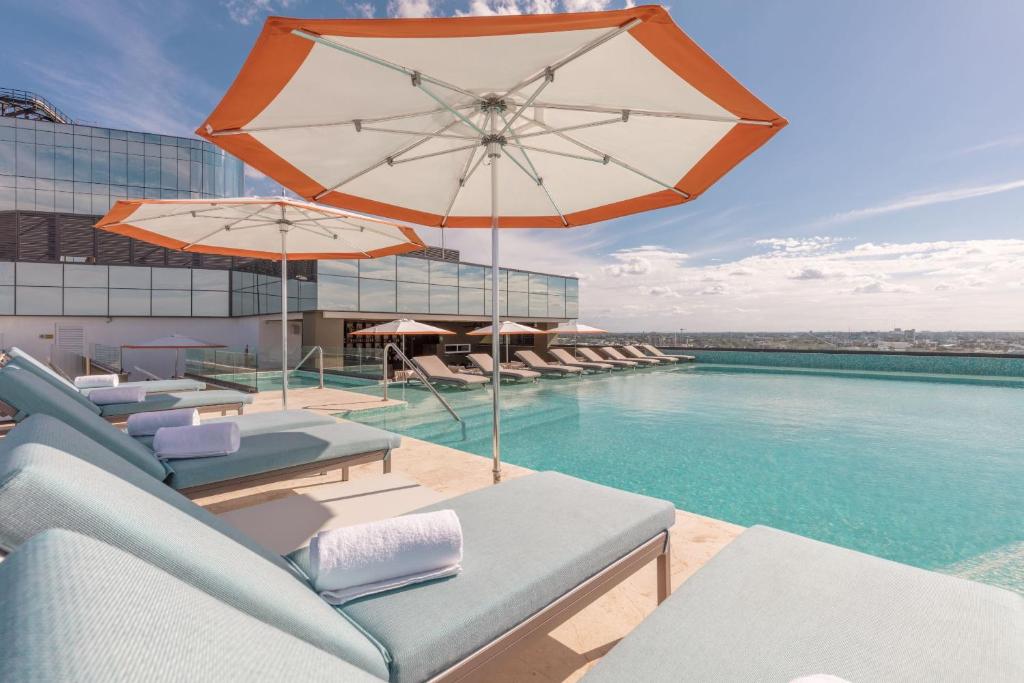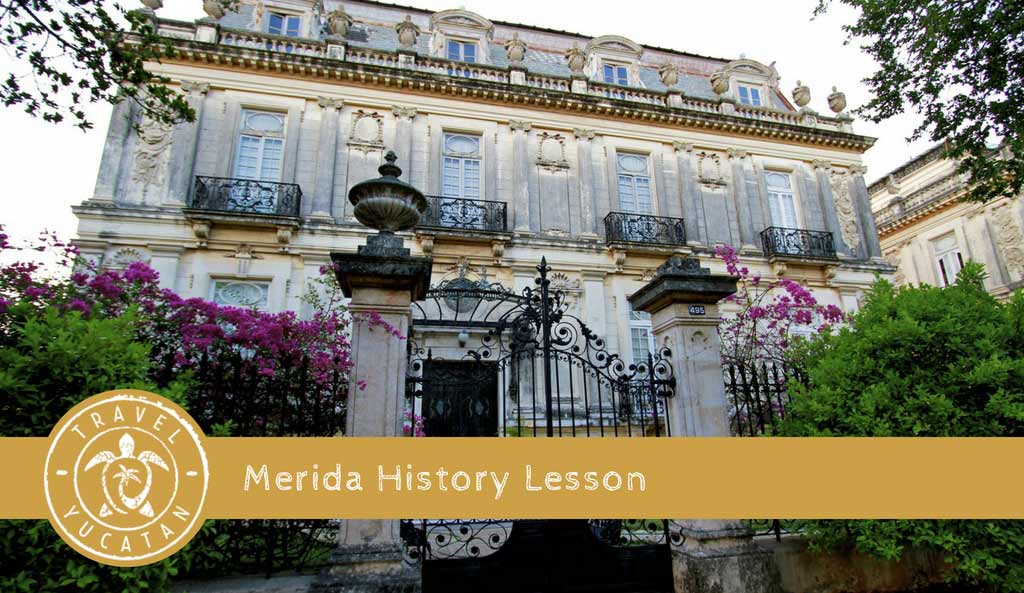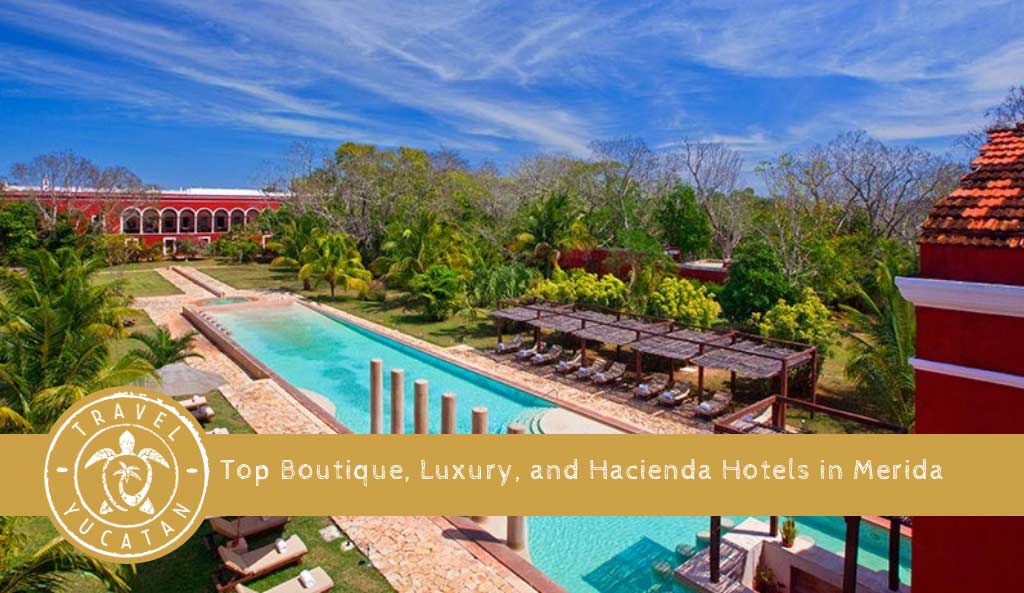Hi! My name is Isabelle and I’m a 39-year-old Canadian/Quebecoise. I live in beautiful Quebec City, Canada, and I’d say my love for my home town is only equaled by my passion for traveling! As a Canadian living in one of the snowiest cities of the country, I’m always on the lookout for some place warm and sunny comes wintertime. Last year, that warm and sunny place turned out to be Mérida in Mexico’s Yucatán Peninsula. I first heard about Mérida through my friend Catherine who spent a year living in the Yucatán and just wouldn’t stop raving about the fabulous time she had while she was there. Curiosity got the best of me and I did a bit of research on my own. Soon enough, I wanted to go too!
Mérida is located about 300 km west of Cancun and about 35 km south of the Gulf of Mexico, so to the many people who asked me how the beach was, I had to reply that the hotel’s swimming pool was pretty nice! Several of them were a bit puzzled as to why anyone from Canada would travel to Mexico during winter and not pick a beach destination, but after spending just a couple of hours walking around this beautiful Colonial city, I knew I had made the right choice! Mérida is often called the “White City” of Mexico, though no one seems to know for sure how this nickname came about. Today, it might have something to do with how safe the city is. The state of Yucatán has the lowest crime rate of the country, and Mérida itself is considered the safest city in all of Mexico.
Mérida was officially founded in 1542 by Francisco de Montejo Jr over the remains of the ancient Mayan city of T’ho. In the late 19th to early 20th century, the city prospered thanks to the commerce of sisal with Europe. It is believed that at the time, Mérida was home to more millionaires than any other city in the world! The city’s wealthy past accounts for several of its residents traveling to Europe and bringing back some French architectural influences, which are mostly noticeable in Mérida’s historic district (Centro) and along the beautiful Paseo de Montejo. However, as the capital of Yucatán, which is home to one of the largest indigenous populations in Mexico, the city of Mérida is also steeped in Mayan culture, and its citizens are very proud to share their roots with visitors, which to me made for a most wonderful travel experience!
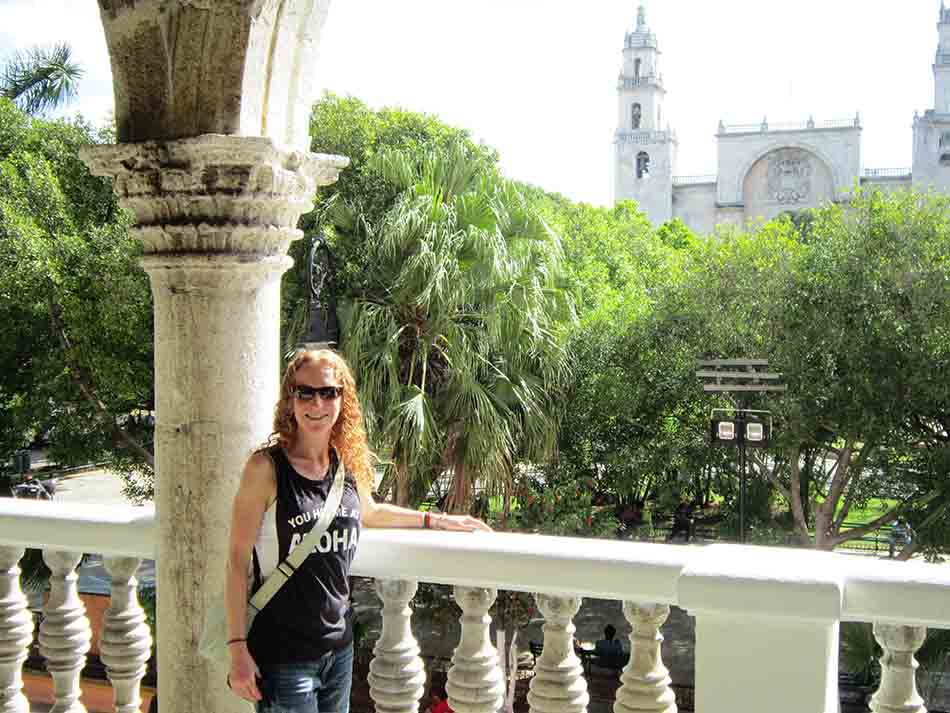
Standing on the balcony of Mérida’s Palacio Municipal, in front of Plaza Grande
We traveled to Mérida in February 2015 and stayed at Hotel del Gobernador, on Calle 59, which was a very nice hotel. The location was perfect: just a short walk away from the city’s main plaza and most attractions, with several good restaurants nearby, but just sufficiently out of the way to make it a quiet place.
I could hardly believe how many free activities were offered in Mérida! The first we took advantage of was the two-hour free guided tour in English of Plaza Grande, which is offered every morning (except on Sundays). These tours make for a wonderful introduction to the city since several of the city’s most important buildings were built around Plaza Grande, starting of course with the Cathedral and la Casa de Los Montejos, the Palacio de Gobierno (State House) and the Palacio Municipal (City Hall).
After the tour, we decided to explore some of these buildings on our own. The first one we went into was the Cathedral de San Ildefonso. Dating back to the 16th century, it is the oldest surviving cathedral on the American mainland. Because of how old it is, both its exterior and interior are hardly decorated at all, except for a gigantic wooden crucifix standing behind the main altar called “Cristo de la Unidad” (Christ of Unity), a symbol of the reconciliation between Spanish and Mayan heritage and cultures.
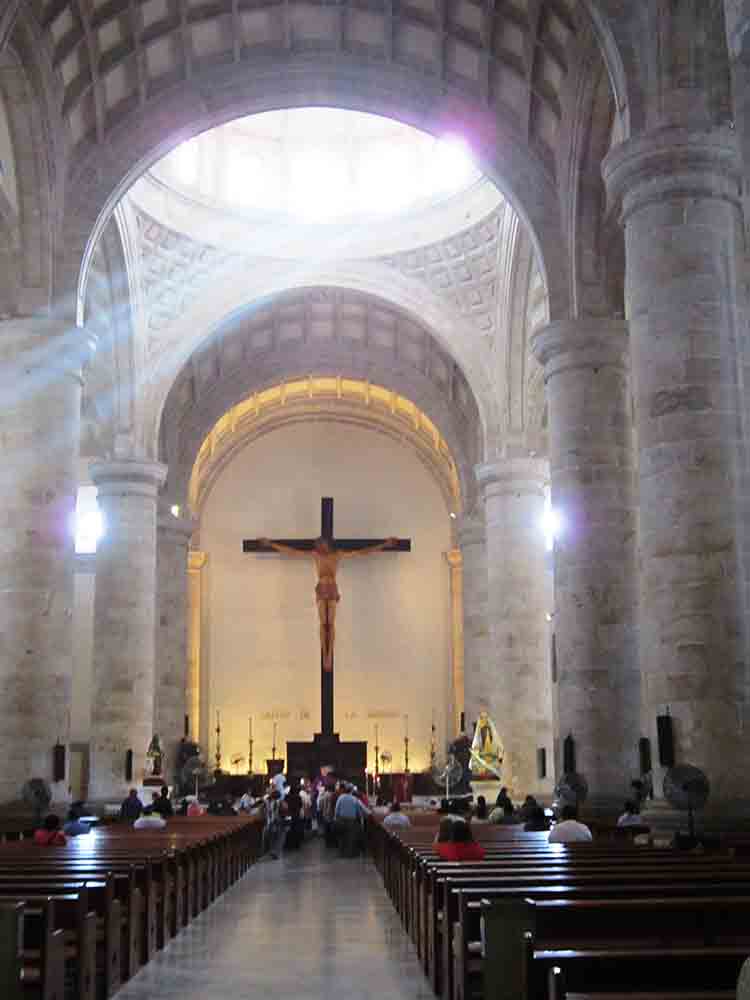
Inside Mérida’s Cathedral de San Ildefonso
Next, we stopped by Mérida’s Palacio de Gobierno (Governor’s Palace), which houses the state of Yucatán’s executive government offices. Besides admiring its lovely Colonial architecture, the main reason why I’d recommend visiting the Palacio would be to take a look at the fantastic collection of historical paintings completed in 1979 by local artist Fernando Castro Pacheco. It took him 8 years to complete this visual history of the Mayan people after the Spanish conquest. The larger-than-life paintings can be seen on the walls of the central staircase, in the corridors around the courtyard, and in the “Hall of History”, all of which are open to the public.
Another site worth mentioning can be found right next to the Palacio: it’s a small shopping center that houses the Pasaje Picheta, named after the local artist whose cartoons depicting 19th century scenes are reproduced as murals on the walls. These paintings really helped me picture what our Plaza Grande tour guide was saying about Mérida being influenced by French culture at the time since men are portrayed wearing tuxedo outfits, complete with a cane and a top hat, which is not exactly how I pictured Mexico 100 years ago!
Then, on the south side of Plaza Grande, you’ll find la Casa de los Montejo, a Colonial mansion that was built in the 1540s for the Montejo, the family of Spanish conquistadors who founded the city of Mérida in 1542. I thought it was interesting that the house remained in the hands of the Montejo descendants until 1832. It has been remodeled throughout the years, but the facade has mostly been left in its original state. It still features the Montejo family’s coat of arms, flanked on each side by two figures of rather dubious taste. These depict two soldiers with their feet resting on four heads, representing the submission of the Mayan people to the Spanish invaders.
Located next to the cathedral on the east side of Plaza Grande, the Ateneo Peninsular was built between 1573 and 1579 as the archbishop’s palace. In 1994, it became the Museo Fernando García Ponce, better known as MACAY, Yucatán’s museum of contemporary arts (Museo de Arte Contemporáneo Ateneo de Yucatán). Unfortunately, the main building was closed for restoration at the time of our visit, but I did enjoy walking through the sculpture garden housed in the Pasaje de la Revolucion.
This completed our tour of Plaza Grande, but of course, there was a lot left to see in the city! So we began by walking up Calle 60 to see the main building of the Universidad Autonoma de Yucatán. This university is ranked as the top public university in the country, and its main building is still located in the original Colonial-style college building (called Edificio Central), which dates back to 1618. We took a quick look around the university’s lovely inner courtyard, and I found it hard to believe that such a beautiful building could actually be a school and that the people we met were actually students going about their day – nothing against my own Alma Matter, but its bland concrete buildings are miles away from what we saw at Mérida’s Universidad Autonoma de Yucatán!
On the way to the university, we spotted the lovely Parque Hidalgo. Created in 1871, it is the city’s oldest park after Plaza Grande. The park itself is not very big – it’s more like a small plaza – but it’s quite picturesque. Parque Hidalgo is surrounded by two historic hotels that are well worth making the short detour. The first would be the Gran Hotel de Mérida. Built in 1901, it was the very first hotel in the city, and it was built at the height of the city’s prosperity. As with many of the buildings that were constructed during that period, it’s quite easy to see the European influence in the architecture of this hotel, and the lobby does bear testimony to how “grand” it must have been at the time.
Hotel Caribe is more recent, but the building in which it is located is actually older. It is located in the cloisters of the Catholic school of San Ildefonso’s seminary, dating back to 1867. The building was beautifully restored, keeping as many historical details as possible, and turned into a luxury hotel. Walking around Hotel Caribe’s beautiful lobby and inner courtyard will allow you to see several elements dating back to its cloisters days.
Across the street from Parque Hidalgo is the Iglesia de la Tercera Orden. When it was built, the church was called (and is still widely known as) the “Iglesia de Jesu”, in honor of the religious community under whose care it originally was. Unlike the bigger, rather barren cathedral, this baroque-style church is tastefully decorated with delicate floral motifs. When the Jesuits were expelled from the Spanish colonies in the wake of the 1767 Jesuits’ Suppression, the church was left deserted until Third-Order Franciscans took over, hence its official name of Iglesia de la Tercera Orden. The biggest change brought about by the Franciscans is that they opened the church to the public (as opposed to the Jesuits who only admitted members of their community), and visitors are more than welcome to have a look too! Also, while you’re in the area, don’t miss the Parque de la Maternidad located right next to the Iglesia de Jesu. It is a small but very nice little square that features a beautiful statue of a young woman watching over her two children. The park is dedicated to motherhood.
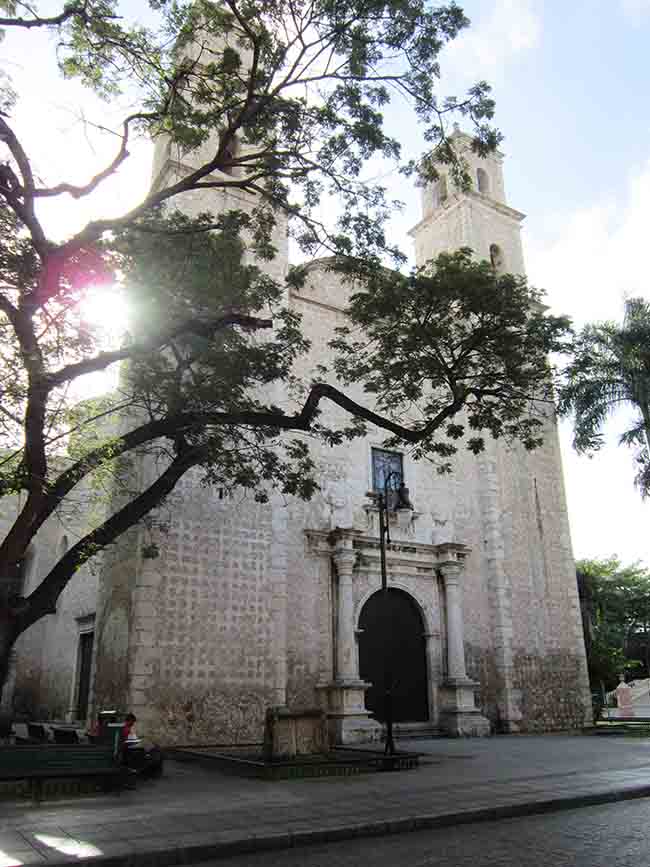
Iglesia de la Tercera Orden, on Calle 60
Mérida has plenty more of lovely historic churches that are worth taking a look at. In the city’s historic district alone, there are at least a dozen churches that can be visited on foot. The ones I visited were not as heavily decorated as what I’ve come to expect from Catholic churches; instead, they all shared a simple beauty that reminded me of the Spanish Colonial missions I had seen in Texas and California (makes sense, I guess!). Churches in Mérida can usually be visited in the morning or in the late afternoon/early evening. By the way, I was a little worried about observing proper clothing etiquette when visiting churches in Mérida given how a large portion of the population in Mexico defines itself as practicing Catholics. But after walking into a church while a service was going on, I quickly realized by looking at the attendance that wearing shorts and a tank top to go to church doesn’t seem to be a major cause for concern. So whether you enjoy religious travels, architecture or history, I suggest you take the time to look up at least a few of the city’s historic churches.
As I’ve already mentioned, towards the end of the 19th century, the state of Yucatán prospered thanks to the commerce of sisal with Europe, a plant that even came to be known as “green gold”. This close relationship with the old continent had a lot of influence on the development of Mérida, which is something that can still be seen in its architecture today. For example, courting benches, also called conversation benches or kissing benches (depending on how well the courting is going, I’m assuming?!) can be found all over the city of Mérida. These benches were very popular in France back in the 19th century, which is when wealthy Meridians began traveling to Europe and bringing in the latest trends from the old continent. Many upper-class residents spoke French fluently (France was the main importer of Yucatán’s sisal), and those who could afford it would dress up in the latest French fashion (which, needless to say, was not very well suited to the climate of Mexico!).
But nowhere in the city can this French influence be seen more than on Paseo de Montejo. Named after the man who founded the city, this important avenue is often described as the “Mexican Champs-Élysées”. When plans were laid out to build the avenue in 1888, a few roundabouts were included in its design. Each features a monument, but none are as impressive as the Monumento a la Patria, which is located at the official end of the avenue. The monument was sculpted by Colombian artist Romulo Rozo and unveiled in 1956. It features different scenes pertaining to the long and rich history of Mexico, from the founding of Teotihuacan to the Spanish Conquest and the Mexican Revolution. But the focal point of the monument is an impressive 14 ft tall stone figure of a Metizo, carved and decorated in the typical Mayan style, staring sternly at the avenue.
I truly enjoyed strolling along Paseo de Montejo and looking at its beautiful mansions. While the beauty of some of them has somewhat faded away, others have been beautifully maintained or restored. One such building is the Italian Renaissance-style Palacio Canton, which now houses the Museum of Anthropology. La Quinta Montes Molina is another fine example of the mansions built in the Neoclassical French style during the sisal boom, and it is open to the public. A visit to La Quinta Montes Molina gives vistors a pretty good insight into the life and times of wealthy Meridians during the sisal era since most of the house’s early 20th century furniture and amenities have been preserved. I thought it was the perfect way to immerse ourselves in the history of the city, and a great way to complete our walk up Paseo de Montejo!
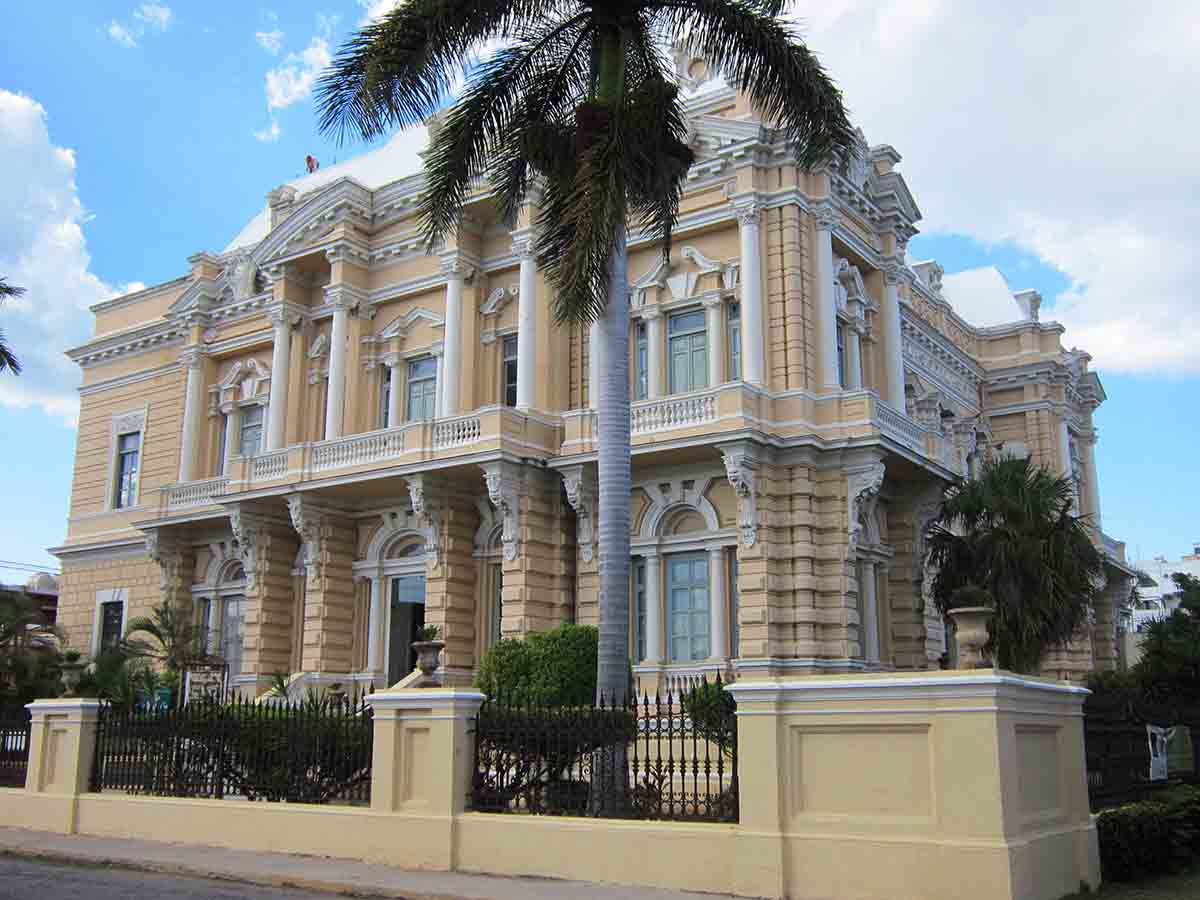
Placio Canton on Paseo de Montejo
I really wanted to go back and see Paseo de Montejo all lit up in the evening, and we thought going on a horse carriage ride might be a nice way to do it. Now let’s face it, horse carriage rides practically always are tourist traps, but they can be a lot of fun too, and since the ride wasn’t too expensive (300 pesos), we decided to go for it. I’ll admit it, part of it was indeed a lot of fun: our horse was pretty feisty, so our romantic carriage ride had more to do with riding a chariot a la Ben-Hur, which I thoroughly enjoyed! Usually, carriage drivers have a speech prepared and act a bit like tour guides, but in this case our driver merely pointed out the different buildings as we rode by. About halfway up Paseo de Montejo, he stopped and told us this is where the ride ended for 300 pesos – but for another 100 pesos he would drive us further down to the Monumento a la Patria. I could hardly believe my ears, what a racket! Granted, 100 pesos isn’t that much, and I might have been willing to pay the whole 400 pesos from the get go, but to be told halfway through the trip that we had to pay extra or else he would have to turn around, now that felt like such a tourist trap! And the worst part is that when we politely declined the offer, he drove back to Plaza Grande without ever saying another word to us, as if WE were the ones who had cheated HIM! So make sure to check beforehand if the Monumento de la Patria is included in the price of the ride. That way, you’ll avoid the nasty surprise we had halfway through the ride.
Another stop we made in Mérida was at Mercado Lucas de Galvez, the city’s central market. Dating back to 1887, this market is huge! What started out as just a few outdoor produce stands has grown into a covered marketplace that houses over 1000 stands selling all the items you can think of: next to fresh fruits and vegetables, you’ll find spices, flowers, handicrafts, shoes, clothes, CDs, DVDs, toys, and even pets! The market spills over onto the nearby streets and alleys, which are just as equally filled with stands. I’m sure the locals all have their favorite vendors, but how they go about finding them in this labyrinth of stands is beyond me because I quickly got completely lost and had to rely on my husband to help me navigate through the market and eventually find my way out. The place is filled with people, colors, noises, smells (most good, some not so much!) day and night. So whether you plan on buying anything or not, I’d say walking around Mérida’s market district is a truly unique experience that shouldn’t be missed!
One of the very cool things about Mérida is that there’s something going on every night of the week because the municipal office of tourism puts on a series of free concerts: on Monday nights at 9:00 pm, in front of the Palacio Municipal (City Hall) by the Grand Plaza, there’s a “Vaqueria”, a celebration that dates back to the 18th century, when wealthy ranch owners would put on huge fiestas to celebrate branding time. On Tuesday nights at 8:30 pm, there’s a show called “Musical Memories” at Parque Santiago. This show features Big Band music from the 1940s performed by a live orchestra and is mostly attended by locals who gather every week to dance the mambo or cha-cha-cha. Even though we couldn’t join them on the dance floor, it was great fun to watch! On Thursday nights, starting at 9:00 pm at Parque Santa Lucia, there’s a show called “Serenata Yucateca”. This trova music concert has been performed by a live orchestra every Thursday night for over 40 years! On the Friday night at 8:00 pm, we very much enjoyed having the opportunity to watch the game of Pok-ta-Pok (Mayan ball game) played in front of the Cathedral. All the customs and traditions surrounding this ceremonial ball game are very well explained, and the players really get into it! Unfortunately, we had to spend Saturday night in Cancun to catch our flight back home, but if you’re lucky enough to be in Mérida on that night, you have the choice between attending another live music concert called “El Corazón de Mérida” at 9:00 pm in the Plaza Grande area, which features jazz, salsa and trova music, or going to the “Noche Mexicana” event (that would have been my pick!), which starts at 8:00 pm at the Remate of Paseo de Montejo. A stage is set up for the occasion, and contemporary music and dance groups from all over Mexico are invited to perform. Booths are also set up for people selling handicrafts and for food merchants. Finally, all day long on Sunday, the entire Centro area is taken over by an event called “Merida en Domingo”. Booths selling handicrafts, clothes and plenty of food are set up in Plaza Grande, and the portion of street stretching in front of the Palacio Municipal becomes a gigantic dance floor in the evening. So much fun! And did I mention that all of these activities are free?
Food definitely is one of the perks of visiting the Yucatán area, and Merida has several good restaurants that specialize in local cuisine. La Chaya Maya, La Casa de Frida and Amaro are all excellent choices for dinner. I also enjoyed eating at the terrace of Soberana Café in Parque Santa Lucia, and on the sunny patio of La Jarana at Plaza Grande. The most popular place for ice cream in Mérida probably is the Dulcería y Sorbetería Colón, but Porque No? was the one for me! This small gelato parlor offers an amazing selection of handmade gelato flavors, many of which have a Mexican twist: lime & yerba buena, watermelon with habanero chili, pineapple & cucumber… and they were all excellent!! We also had breakfast at Café La Habana, Los Trompos and Los Bisquets Obregón, which were good, though nothing out of the ordinary. But on our last morning in Mérida, we discovered the Panificadora Y Pasteleria Montejo in the southwest corner of Plaza Grande. This little bakery doesn’t look like much from the outside and, to be honest, there isn’t much inside either, except for dozens of trays filled with mouth-watering pastries of all kinds!
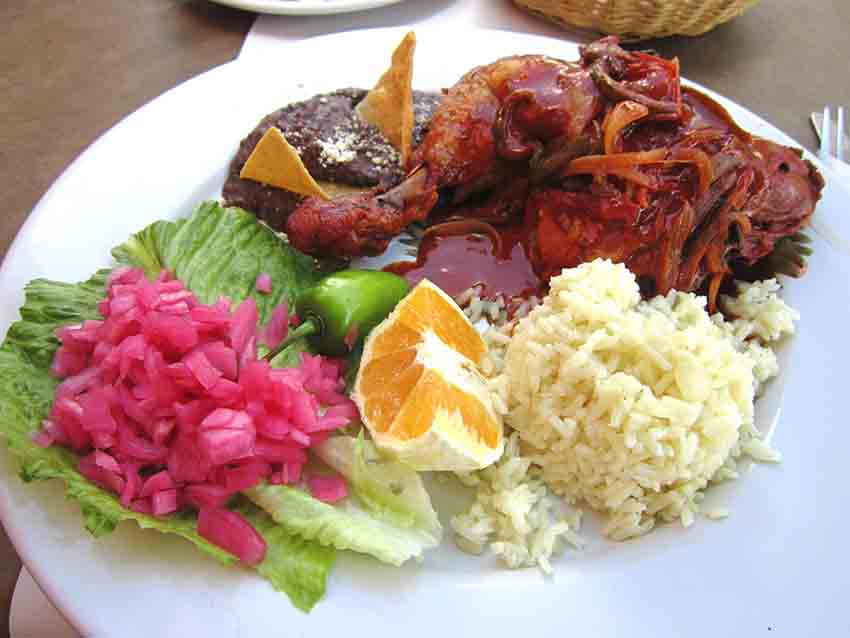
Pollo pibil, one of the region’s delicious specialties.
One thing that is great things about Mérida is that it makes for a fantastic base camp to explore the rest of the state of Yucatán. The remains of about 60 ancient Mayan cities have been discovered in the Yucatán to this day, but perhaps none are as famous as Chichén Itzá, whose great pyramid (also known as El Castillo or Temple of Kukulkan) has been named one of the Seven Wonders of the modern world. There are several more archeological sites worth exploring in the area, and since Yucatecos are proud of their Mayan heritage, they will love helping you discover it!
Since we didn’t feel like driving or having to worry about keeping up with bus schedules (we were, after all, on vacations!), we booked all of our day trips with tour operators. As I was planning my trip to Mérida, I found it incredibly hard to find information about which excursions we should book with which tour operators, something that I hope this website will help with. In the end, for our day trip to Chichén Itzá, we decided to book an excursion with Mayan Ecotours. Overall, our guide Miguel did a pretty good job. We didn’t have to wait long before seeing the ancient city’s masterpiece, the Temple of Kukulkan, since the 24 m high pyramid is located near the site’s entrance. But there are many other interesting monuments on the site, which covers a total area of about 5 km2, starting with the great ball court. The Temple of the Warriors and its thousand columns are also very impressive. A short walk will lead you to the sacred cenote, in which archeologists found many human bones, thus indicating that it was used to perform human sacrifices.
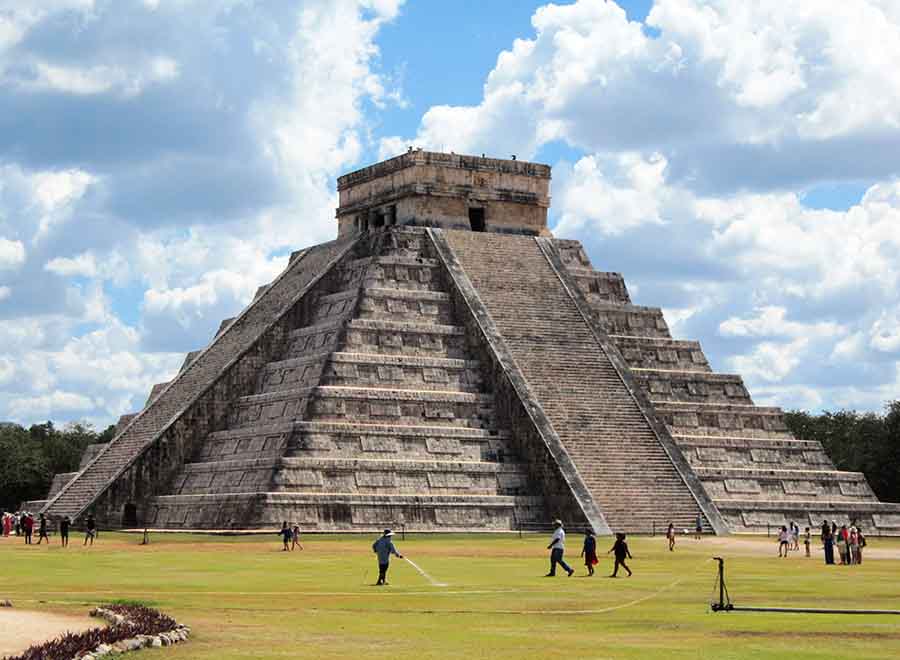
Temple of Kukulkan, Chichén Itzá.
Because of all the clearing that’s been done at Chichén Itzá, there isn’t a whole lot of shade on the site so it can get really hot. For this reason, a popular thing to do after visiting the archeological site is to go for a swim at Cenote Ik Kil. The water of this beautiful open-sky cenote is about 26 m (85 ft) below ground (a stairway leads down to the water level). The site is well equipped with changing rooms and showers, and a small store where you can rent life jackets. The cenote is quite large, measuring about 60 m in diameter, and it’s about 40 m deep. I doubt it ever gets overcrowded; in fact, for some reason, there seemed to be more people looking down at the swimmers from up above than people actually in the water when I was there. They truly missed out for the water pretty much was at the perfect temperature: refreshing, but far from freezing, and the waterfalls and vines all around the cenote make for a beautiful spectacle as you look up to the blue Mexican sky. And in case you’re wondering, Ik Kil was never used for human sacrifices; the Mayans used it to perform different rituals and for relaxation purposes – and I can’t blame them!
After speed walking through Chichén Itzá in the morning and swimming at Cenote Ik Kil in the early afternoon, I was more than ready for lunch! Our guide took us to Hacienda Chichén, one of the very first haciendas to be built in the Yucatán Peninsula. It seemed rather perfect to be having lunch in the very same place where archeologist Edward Herbert Thompson lived while he explored the famous Mayan site. Hacienda Chichen’s large dining room is perfect for large parties (they specialize in hosting weddings and tour buses), and the buffet truly was excellent!
Another archeological excursion we went on was to the sites of Uxmal and Kabah. Because Uxmal hasn’t received as much attention as Chichén Itzá, not as many archeological excavations and restoration work have taken place, which is exactly the reason why many people actually prefer visiting Uxmal to Chichén Itzá. While I can’t say I share that opinion entirely, I did enjoy how accessible the buildings were. While visitors can no longer climb up the site’s tallest pyramid for safety reasons, none of the other buildings are off limits. However, I think I would have enjoyed my visit even more had our tour guide been better. Again, we had booked our excursion with Mayan Ecotours. Once we got to Uxmal, our guide Raúl seemed more interested in chatting with his tour guide buddies than actually leading our group through the ruins, and his knowledge of the site seemed rather limited. One thing that really bugged me is that he insisted on collecting the money and buying the entry tickets for us, and never gave us back the change. It was only 2 pesos per person, but it seemed rather dishonest to me.
The second part of the excursion took us to Kabah, the second largest Mayan site after Uxmal on the Ruta Puuc, which is the name of the road that goes through Yucatán’s hill country, connecting several ancient Mayan sites. The beginning of the road to Uxmal is marked by an impressive monumental arch, which we would have missed had I not found the information in the paper guide I had brought with me since our guide only gave us minimal information about the site before telling us how much time we had to explore the site on our own.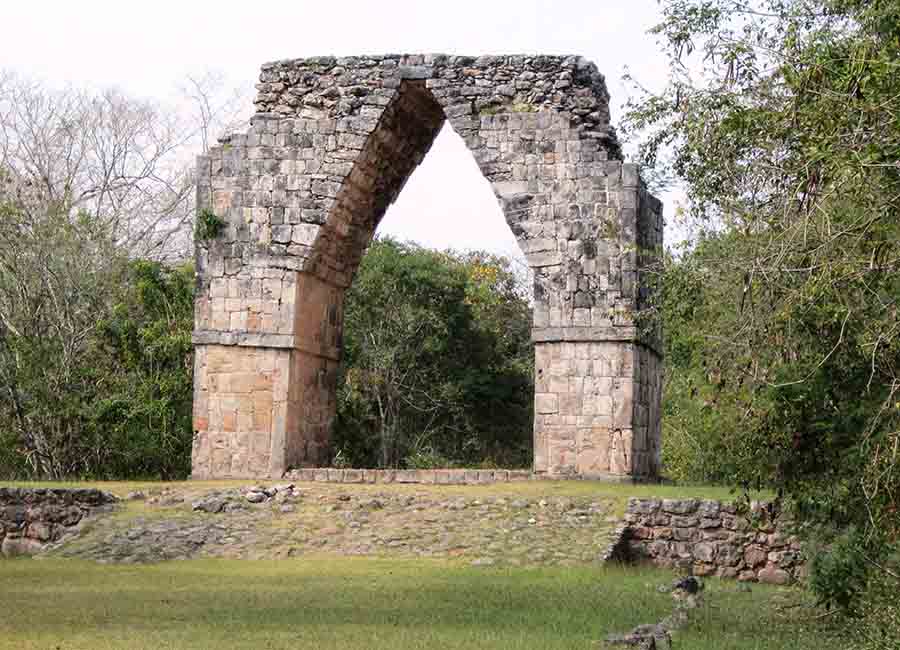
Ruta Puuc archway in Kabah.
To say that these last two sites are in the middle of nowhere would be a bit of a stretch, but there is very little around so your options for lunch in the area are rather limited. Our guide Raúl took us to Cana-Nah, a restaurant that caters to tour buses and the occasional lone visitor. Even if the dining room is rather large, there was still a cosy atmosphere that gave the place a somewhat more typical ambience. The entire group seemed extremely satisfied with their meals, so even though he probably had no say in the matter, I’d still like to think that Raúl tried to redeem himself by taking us to Cana-Nah for lunch!
Another place I really wanted to visit on our trip was the Celestun National Wildlife Refuge. This huge biosphere reserve is home to hundreds of migrating bird species, sea turtles and crocodiles, but what makes it so special is the large number of pink flamingos that overwinter in the reserve. The first thing we did when we got to the park was to take a boat tour out on the estuary. Our boat driver took us close enough to the flamingos, but always made sure to keep a healthy distance so as not to frighten them. To see thousands of flamingos at once is quite a spectacle!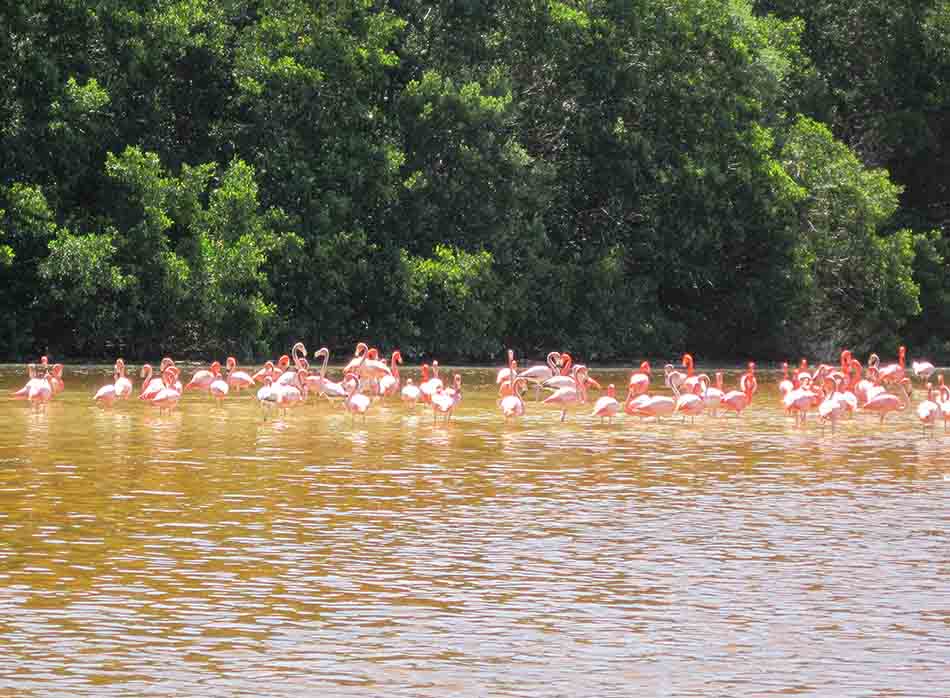
Pink famingos at the Celestun National Wildlife Refuge.
Next, we drove up to the delightful seaside town of Celestun, where we had plenty of time to walk around the quaint little fishing town and go for a swim in the Gulf of Mexico. The beach in Celestun in simply beautiful and, unlike most resort towns, chances are you’ll have it almost exclusively to yourself! Celestun has the reputation of offering some of the best fish and seafood in the state, with octopus being a local specialty. It’s not exactly a big town, so there only is a limited number of options when it comes to picking a restaurant, but who cares when you get to enjoy fresh seafood no matter where you go?! Our guide took us to La Palapa, a nice restaurant located right on the beach. The dining room is huge, which made me feel like we had yet again walked into a place that specializes in welcoming tour buses after their trip to the Wildlife Refuge. While this might indeed have been the case, it didn’t take anything away from the quality of the food we were served. Since the restaurant is right on the beach, there are changing rooms and showers available for the restaurant’s patrons. While it felt a bit weird to be walking around a restaurant in my swimsuit, I also thought it was incredibly convenient. I also quickly realized that that’s the way things go in Celestun!
We booked our Celestun excursion with Ecoturismo Yucatán. Our guide was quite friendly and chatty, and he gave us some information about the city as we drove around to pick up the other members of our group. He also gave us some interesting information about the region during the 90-min drive to Celestun. He answered all of our questions about flamingos, took us to that nice seafood restaurant in Celestun, and left us plenty of time to enjoy the beach after our meal. Based on punctuality, transportation, food, guide & overall tour quality, I’d say Ecoturismo Yucatán is a much better tour operator than Mayan Ecotours.
The last archeological site we got to visit on this trip, Dzibilchaltun, is perhaps not quite as popular as the others, but I’d say it was as interesting for sure. We were led to the main part of the site by an excellent tour guide who gave us a brief but very informative introduction to the site, before leaving us with plenty of time to explore the ruins on our own. Some other interesting features of the site include the remnants of civilian habitations, the ruins of a 16th century church built at the time of the Spanish conquest, and the cenote Xlakah. Many precious objects were found at the bottom of this beautiful cenote, which indicates the Mayas used it for sacred rituals instead of human sacrifices. Going for a swim in the crystal waters of this lovely cenote covered with water lilies truly was one of the highlights of my trip!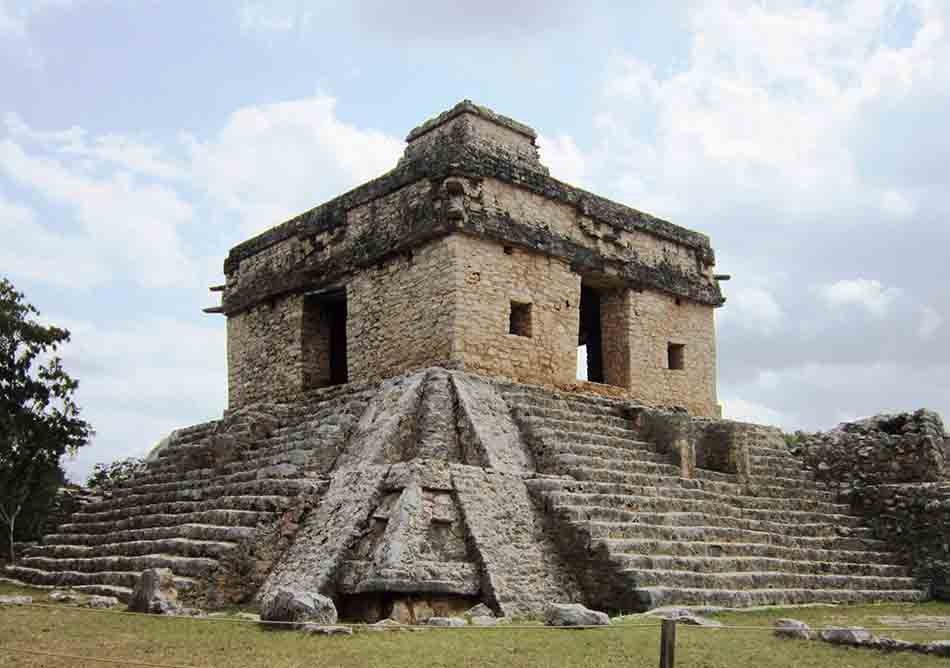
Temple of the Seven Dolls, Dzibilchaltun.
We then stopped by the El Corchito ecological reserve on our way to Progreso. El Corchito is operated by a local cooperative of fishermen, and the whole experience had a nice local feel to it. We were taken to the ecological reserve aboard a small boat, and landed in a beautiful mangrove forest. Some raccoons and coatis were there to greet us as soon as we reached the small dock! There are three natural cenotes at El Corchito: Cenote Helechos, a shallow pool that is perfect for children, Cenote Venado and Cenote Pajaros, which is the largest. There is also a smaller pond full of doctor fish, the same ones you find in spas (and pay a pretty steep price for), so you can get a nice pedicure thanks to these little guys that will come nibbling at your feet.
Our excursion ended in Progreso, a medium-sized port city located on the Gulf of Mexico, about 30 min north of Mérida, which makes it a quick and easy beach escape for visitors and city dwellers. Since we were starving after our adventures at Dzibilchaltun and El Corchito, we were quite happy to rely on our guide for a restaurant recommendation. He took us to Eladio’s, a nice beach front restaurant located at the western end of the Malecon. You can sit inside and enjoy the live music, or you can kick your shoes off and sit at a table right on the beach; of course, we picked the second option! The only thing I found a bit annoying was that beach vendors kept coming to our table, but then again I was very happy when one of them showed up with a tray full of “dulces” (sweets of all kinds!). I took some with me as we began to explore the city on foot. The main attraction in Progreso is the Malecon, the beachfront avenue that stretches for about 10 blocks along Calle 19. The avenue is filled with souvenir shops and restaurants, many of which will set tables right on the beach. We also walked up Calle 80 to see the heart of the city. The street leads from the beach to the city’s main plaza. Along the way, we also walked by the city’s market and lighthouse. You probably don’t need more than half a day to explore Progreso, but it’ll be a half-day well spent!
To book our excursion to Dzibilchaltun/Progreso, we relied on the staff working at the front desk of our hotel. They gave us a couple of options, and Enlaces del Mundo Maya, while being the cheapest, offered the most interesting itinerary. To our surprise, it turned out to be a private tour. Our guide was very friendly and most accommodating. Thanks to him, it turned out to be the best of our four Yucatán excursions!

